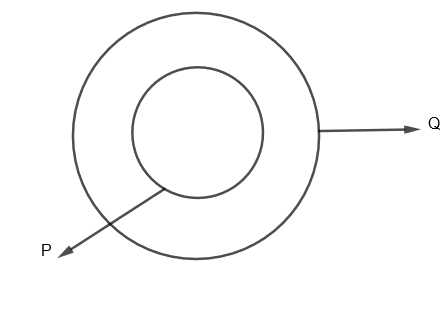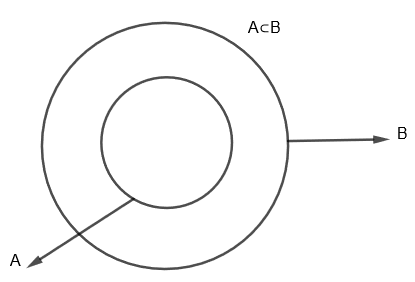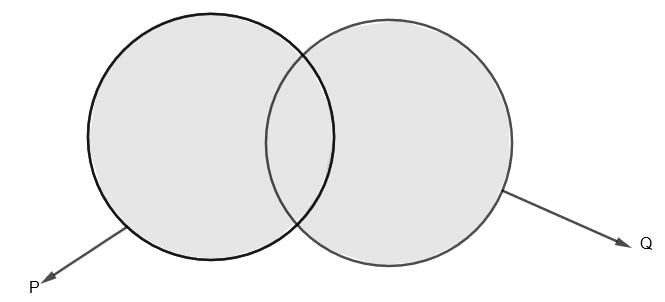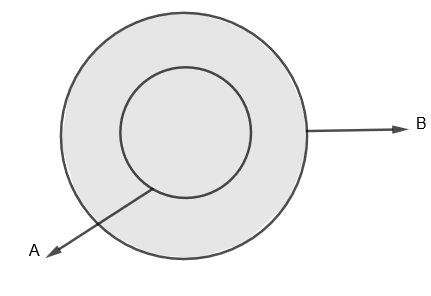
If \[A\subset B,n\left( A \right)=5\] and \[n\left( B \right)=7\], then \[n\left( A\cup B \right)=\]_ _ _ _ _ _ _ _ _.
(a) 5
(b) 7
(c) 2
(d) 12
Answer
606.9k+ views
Hint: Use the formula for union of two sets that is \[n\left( A\cup B \right)=n\left( A \right)+n\left( B \right)-n\left( A\cap B \right)\]. Now, since \[A\subset B\], therefore put \[n\left( A\cap B \right)=n\left( A \right)\], then use the given information that is \[n\left( A \right)=5\] and \[n\left( B \right)=7\].
Here, we are given two sets A and B such that \[A\subset B\], \[n\left( A \right)=5\] and \[n\left( B \right)=7\]. We have to find the value of \[n\left( A\cup B \right)\].
Before proceeding with the question, we must know some of the terminologies related to sets.
First of all, a ‘set’ is a collection of well-defined and distinct objects. The most basic property of a set is that it has elements. The number of elements of a set, say A is shown by \[n\left( A \right)\].
Here, in the question we have \[n\left( A \right)=5\] and \[n\left( B \right)=7\], that means the number of elements in set A is 5, while the number of elements in set B is 7.
Now, a ‘subset’ is a set which is contained in another set. We can also put it as, if we have a set P which is a subset of another set Q, then P is contained in Q as all the elements of set P are elements of Q. This relationship is shown by \[P\subset Q\].
We can show it diagrammatically as,

Here, \[P\subset Q\], that means P is contained in Q as P is a subset of Q.
In question, we are given that \[A\subset B\], that means that A is a subset of B or A is contained in B. We can show them as

Now, union of two sets say P and Q is the set of elements which are in P, in Q or both P and Q. For example, if P = {1, 3, 5, 7} and Q = {1, 2, 4, 6, 7}, then union of P and Q which is shown as \[P\cup Q=\left\{ 1,2,3,4,5,6,7 \right\}\]
Diagrammatically, the shaded portion is \[P\cup Q\] which is as follows

The formula for \[n\left( P\cup Q \right)=n\left( P \right)+n\left( Q \right)-n\left( P\cap Q \right)\].
Here, \[P\cap Q\] is the area common to both P and Q.
Now, in the given question, we have to find \[n\left( A\cup B \right)\], that is, the number of elements in A union B.
We can show \[A\cup B\] by a shaded portion which is as follows.

Here, \[A\subset B\] and \[n\left( A \right)=5\] and \[n\left( B \right)=7\].
Here, we can see that the portion common to the set A and B that is \[\left( A\cap B \right)\] is nothing but set A. Therefore, here we have \[n\left( A\cap B \right)=n\left( A \right)=5\].
As we know that \[n\left( P\cup Q \right)=n\left( P \right)+n\left( Q \right)-n\left( P\cap Q \right)\], therefore to get \[n\left( A\cup B \right)\], we will put A and B in place of P and Q respectively, we will get
\[n\left( A\cup B \right)=n\left( A \right)+n\left( B \right)-n\left( A\cap B \right)\]
Since, we have found that \[n\left( A\cap B \right)=n\left( A \right)=5\].
Therefore we get, \[n\left( A\cup B \right)=n\left( A \right)+n\left( B \right)-n\left( A \right)\]
By putting the values of n (A) and n (B), we get,
\[n\left( A\cup B \right)=5+7-5\]
\[n\left( A\cup B \right)=7\]
Therefore, we get \[n\left( A\cup B \right)=7\]
Hence, option (b) is correct.
Note: Students must note that whenever \[A\subset B\], that is A is subset of B, then \[n\left( A\cup B \right)\], that is the number of elements in A union B is equal to number of elements in set B that is, \[n\left( A\cup B \right)=n\left( B \right)\] when \[A\subset B\]. Also, some students make this mistake of writing \[n\left( A\cup B \right)=n\left( A \right)+n\left( B \right)\] which is wrong. They must remember to subtract \[n\left( A\cap B \right)\] as well. Hence, \[n\left( A\cap B \right)=n\left( A \right)+n\left( B \right)-n\left( A\cap B \right)\].
Here, we are given two sets A and B such that \[A\subset B\], \[n\left( A \right)=5\] and \[n\left( B \right)=7\]. We have to find the value of \[n\left( A\cup B \right)\].
Before proceeding with the question, we must know some of the terminologies related to sets.
First of all, a ‘set’ is a collection of well-defined and distinct objects. The most basic property of a set is that it has elements. The number of elements of a set, say A is shown by \[n\left( A \right)\].
Here, in the question we have \[n\left( A \right)=5\] and \[n\left( B \right)=7\], that means the number of elements in set A is 5, while the number of elements in set B is 7.
Now, a ‘subset’ is a set which is contained in another set. We can also put it as, if we have a set P which is a subset of another set Q, then P is contained in Q as all the elements of set P are elements of Q. This relationship is shown by \[P\subset Q\].
We can show it diagrammatically as,

Here, \[P\subset Q\], that means P is contained in Q as P is a subset of Q.
In question, we are given that \[A\subset B\], that means that A is a subset of B or A is contained in B. We can show them as

Now, union of two sets say P and Q is the set of elements which are in P, in Q or both P and Q. For example, if P = {1, 3, 5, 7} and Q = {1, 2, 4, 6, 7}, then union of P and Q which is shown as \[P\cup Q=\left\{ 1,2,3,4,5,6,7 \right\}\]
Diagrammatically, the shaded portion is \[P\cup Q\] which is as follows

The formula for \[n\left( P\cup Q \right)=n\left( P \right)+n\left( Q \right)-n\left( P\cap Q \right)\].
Here, \[P\cap Q\] is the area common to both P and Q.
Now, in the given question, we have to find \[n\left( A\cup B \right)\], that is, the number of elements in A union B.
We can show \[A\cup B\] by a shaded portion which is as follows.

Here, \[A\subset B\] and \[n\left( A \right)=5\] and \[n\left( B \right)=7\].
Here, we can see that the portion common to the set A and B that is \[\left( A\cap B \right)\] is nothing but set A. Therefore, here we have \[n\left( A\cap B \right)=n\left( A \right)=5\].
As we know that \[n\left( P\cup Q \right)=n\left( P \right)+n\left( Q \right)-n\left( P\cap Q \right)\], therefore to get \[n\left( A\cup B \right)\], we will put A and B in place of P and Q respectively, we will get
\[n\left( A\cup B \right)=n\left( A \right)+n\left( B \right)-n\left( A\cap B \right)\]
Since, we have found that \[n\left( A\cap B \right)=n\left( A \right)=5\].
Therefore we get, \[n\left( A\cup B \right)=n\left( A \right)+n\left( B \right)-n\left( A \right)\]
By putting the values of n (A) and n (B), we get,
\[n\left( A\cup B \right)=5+7-5\]
\[n\left( A\cup B \right)=7\]
Therefore, we get \[n\left( A\cup B \right)=7\]
Hence, option (b) is correct.
Note: Students must note that whenever \[A\subset B\], that is A is subset of B, then \[n\left( A\cup B \right)\], that is the number of elements in A union B is equal to number of elements in set B that is, \[n\left( A\cup B \right)=n\left( B \right)\] when \[A\subset B\]. Also, some students make this mistake of writing \[n\left( A\cup B \right)=n\left( A \right)+n\left( B \right)\] which is wrong. They must remember to subtract \[n\left( A\cap B \right)\] as well. Hence, \[n\left( A\cap B \right)=n\left( A \right)+n\left( B \right)-n\left( A\cap B \right)\].
Recently Updated Pages
Master Class 12 Economics: Engaging Questions & Answers for Success

Master Class 12 Maths: Engaging Questions & Answers for Success

Master Class 12 Biology: Engaging Questions & Answers for Success

Master Class 12 Physics: Engaging Questions & Answers for Success

Basicity of sulphurous acid and sulphuric acid are

Master Class 12 Business Studies: Engaging Questions & Answers for Success

Trending doubts
How much time does it take to bleed after eating p class 12 biology CBSE

Explain sex determination in humans with line diag class 12 biology CBSE

Differentiate between homogeneous and heterogeneous class 12 chemistry CBSE

When was the first election held in India a 194748 class 12 sst CBSE

Explain sex determination in humans with the help of class 12 biology CBSE

December 10th of 1948 is an important day in the history class 12 sst CBSE




